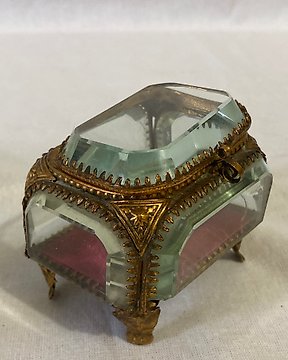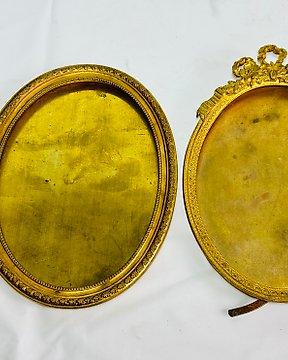
Cutie Bijuterii - Splendid Relicvar Napoleon III 6,5x5,5x7,5 - Alamă, sticlă teșită groasă - cutie de bijuterii, Napoleon al III-lea
Catawiki își actualizează în permanență tehnologia. Momentan folosiți un browser neactualizat. Pentru a vă optimiza experiența, vă rugăm actualizați browserul.
Vă puteți seta preferințele de cookie-uri folosind comutatoarele de mai jos. Puteți actualiza preferințele, să vă retrageți consimțământul în orice moment, și vizualiza o descriere detaliată a tipurilor de cookie-uri pe care noi sau partenerii noștri le utilizăm în Politica noastră de Cookie-uri.
Nr. 88130709






Exquisite Louis XVI style mechanical cylinder bureau with ormolu fittings. The woodwork is extraordinary, but the richness of its decorative ormolu fittings, mercury-gilded bronze and chiselled to achieve these elegant shapes, which are distributed throughout the piece, stands out especially.
This elegant piece of furniture stands on four scroll legs, all of them with sabots. The wood is beautifully inlaid with marquetry on the front and sides.
The desk has beautifully ornamented drawers which lock with the (original) key.
Open the desk with an additional key. When you pull on the knobs attached to the writing top and the desk automatically opens, revealing a green leather writing surface and four additional drawers.
Light, practical and versatile furniture; it can be stored as well as displayed.
The Napoleon III or Second Empire style gets its name from the fact that it was born in France at that time. Strictly, the Second Empire was proclaimed in 1852 and ended in 1870, led by Louis Napoleon Bonaparte as Emperor of the French, although in the artistic sense it extends a few more years (until 1880). This style had a great reception among the French bourgeoisie. The emperor himself was involved in the artistic development of the moment, although more closely linked to architecture. However, it is Empress Eugenia who is responsible for the evolution of the decorative arts.
Although it is inspired by the styles of the past, beginning with Classical Antiquity, the Renaissance, even Louis XVI, much loved by Eugenia, the most representative characteristic of the style is sumptuousness and ostentation, always aspiring to show wealth and opulence.
It is not a style designed specifically for the Second Empire, but a recovery of the different great French styles of the previous centuries, a kind of compilation of French decorative trends. Special reference is made to Louis XIV, Louis XV, Baroque and Rococo, and little by little Louis XVI, with an eclecticist base. In short, the decorative styles that had positioned France at the forefront of interior design and furniture design in Europe, both for quality and for originality and beauty.
They are pieces with great ornamentation. Something very common was the application of elements that simulated bronze, as in this case the brass filleting. The upholstery also lived a moment of splendor, almost completely hiding the structure of the chairs and armchairs. Dark woods, or stained or lacquered in dark colors, were usually chosen, which harmonized with the rich upholstery and gold details.
Total dimensions: 93 x 76 x 42 cm. In
Leg height: 53 cm.
DUE TO THE DIMENSIONS OF THE PIECE, IT IS PREFERRED TO ARRANGE THE COLLECTION OR SHIPPING WITH THE BUYER.
Exquisite Louis XVI style mechanical cylinder bureau with ormolu fittings. The woodwork is extraordinary, but the richness of its decorative ormolu fittings, mercury-gilded bronze and chiselled to achieve these elegant shapes, which are distributed throughout the piece, stands out especially.
This elegant piece of furniture stands on four scroll legs, all of them with sabots. The wood is beautifully inlaid with marquetry on the front and sides.
The desk has beautifully ornamented drawers which lock with the (original) key.
Open the desk with an additional key. When you pull on the knobs attached to the writing top and the desk automatically opens, revealing a green leather writing surface and four additional drawers.
Light, practical and versatile furniture; it can be stored as well as displayed.
The Napoleon III or Second Empire style gets its name from the fact that it was born in France at that time. Strictly, the Second Empire was proclaimed in 1852 and ended in 1870, led by Louis Napoleon Bonaparte as Emperor of the French, although in the artistic sense it extends a few more years (until 1880). This style had a great reception among the French bourgeoisie. The emperor himself was involved in the artistic development of the moment, although more closely linked to architecture. However, it is Empress Eugenia who is responsible for the evolution of the decorative arts.
Although it is inspired by the styles of the past, beginning with Classical Antiquity, the Renaissance, even Louis XVI, much loved by Eugenia, the most representative characteristic of the style is sumptuousness and ostentation, always aspiring to show wealth and opulence.
It is not a style designed specifically for the Second Empire, but a recovery of the different great French styles of the previous centuries, a kind of compilation of French decorative trends. Special reference is made to Louis XIV, Louis XV, Baroque and Rococo, and little by little Louis XVI, with an eclecticist base. In short, the decorative styles that had positioned France at the forefront of interior design and furniture design in Europe, both for quality and for originality and beauty.
They are pieces with great ornamentation. Something very common was the application of elements that simulated bronze, as in this case the brass filleting. The upholstery also lived a moment of splendor, almost completely hiding the structure of the chairs and armchairs. Dark woods, or stained or lacquered in dark colors, were usually chosen, which harmonized with the rich upholstery and gold details.
Total dimensions: 93 x 76 x 42 cm. In
Leg height: 53 cm.
DUE TO THE DIMENSIONS OF THE PIECE, IT IS PREFERRED TO ARRANGE THE COLLECTION OR SHIPPING WITH THE BUYER.








